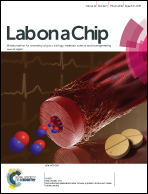Dielectrophoretic immobilisation of antibodies on microelectrode arrays
Abstract
A silicon based chip device with a regular array of more than 100 000 cylindrical sub-microelectrodes has been developed for the dielectrophoretic (DEP) manipulation of nanoparticles and molecules in solution. It was fabricated by a standard CMOS (complementary metal oxide semiconductor) compatible process. The distribution of the electrical field gradient was calculated to predict the applicability of the setup. Heating due to field application was determined microscopically using a temperature sensitive fluorescent dye. Depending on voltage and frequency, temperature increase was found to be compatible with protein function. Successful field controlled immobilisation of biomolecules from solution was demonstrated with the autofluorescent protein R-phycoerythrin (RPE) and with fluorescently labelled IgG antibodies. Biological activity after DEP application was proven by immobilisation of an anti-RPE antibody and subsequent binding of RPE. These results demonstrate that the developed chip system allows the directed immobilisation of proteins onto microelectrodes by dielectrophoresis without the need for any chemical modification and that protein function is preserved. Being based on standard lithographical methods, further miniaturisation and on-chip integration of electronics towards a multiparameter single cell analysis system appear near at hand.


 Please wait while we load your content...
Please wait while we load your content...